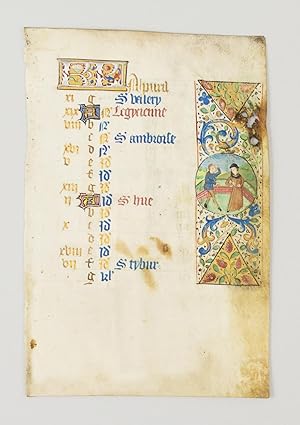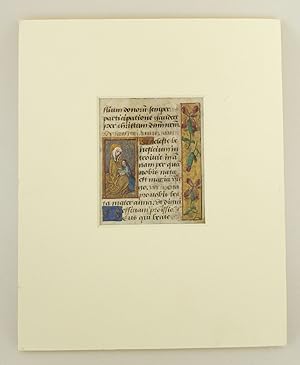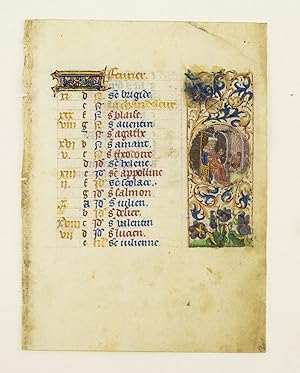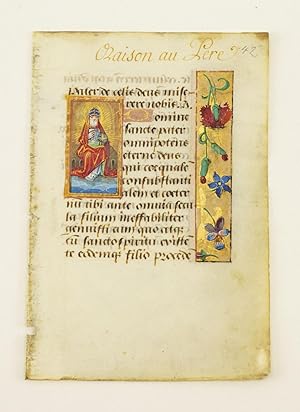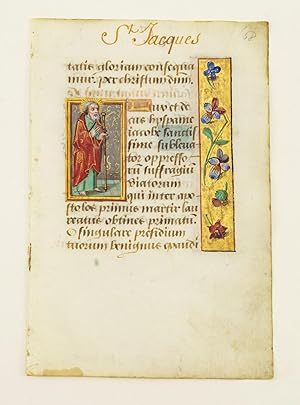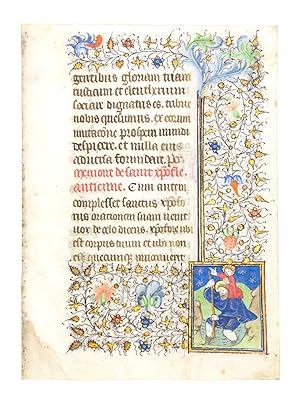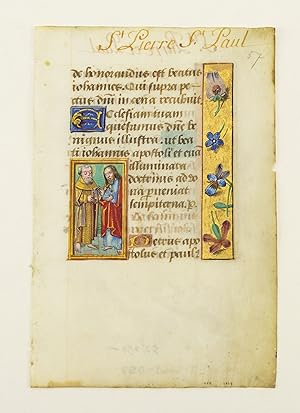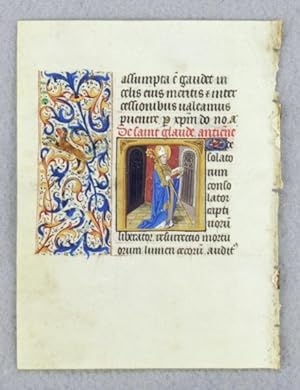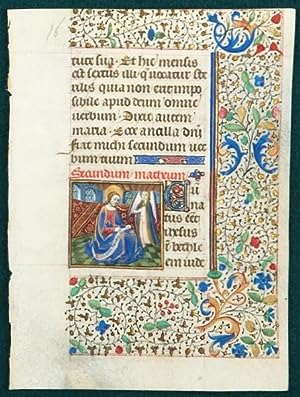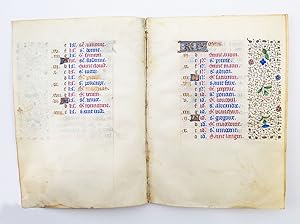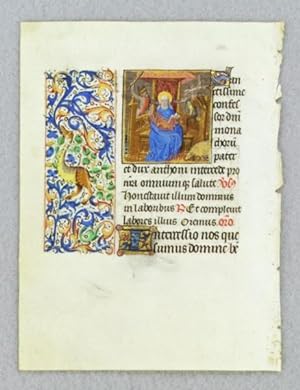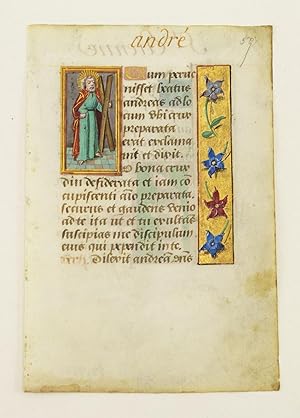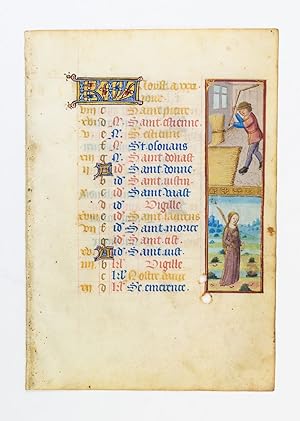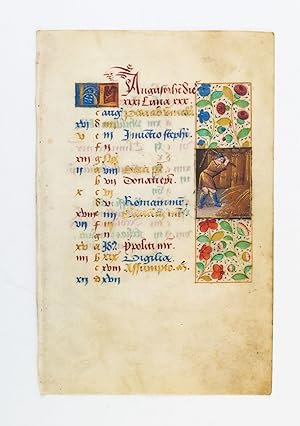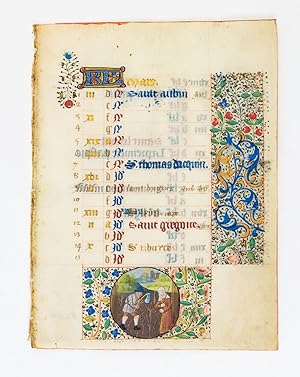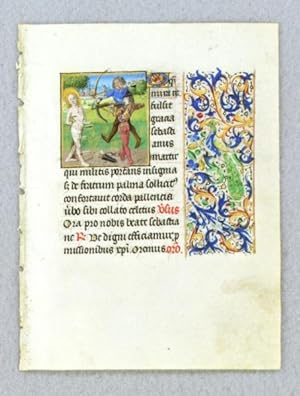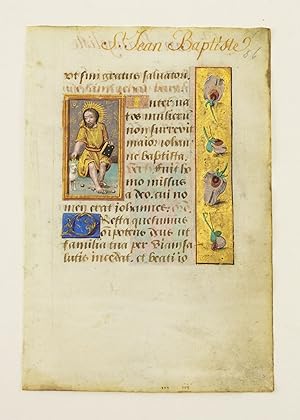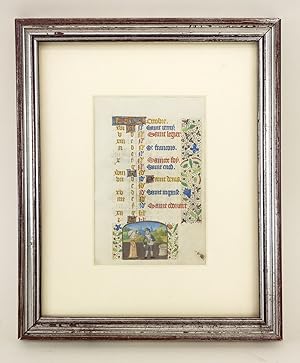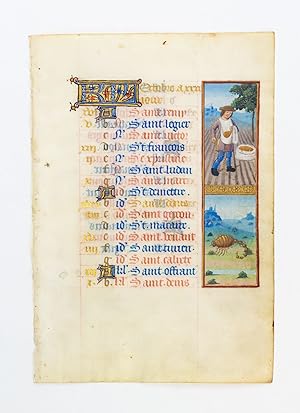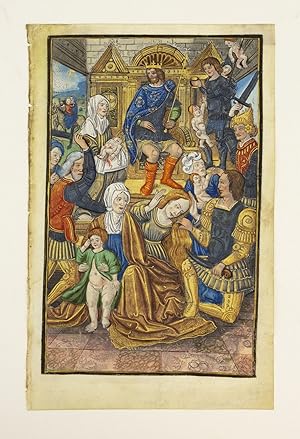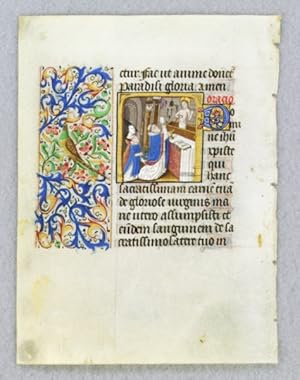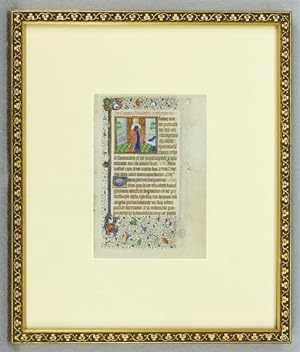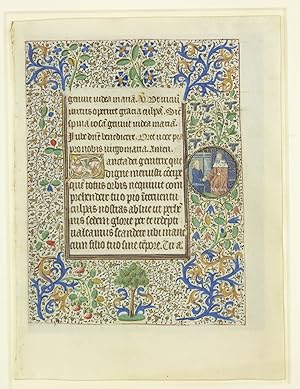Illuminated Book of Hours (48 results)
Product Type
- All Product Types
- Books (48)
- Magazines & Periodicals
- Comics
- Sheet Music
- Art, Prints & Posters
- Photographs
- Maps
-
Manuscripts &
Paper Collectibles
Condition
- All Conditions
- New
- Used
Binding
- All Bindings
- Hardcover (1)
- Softcover
Collectible Attributes
- First Edition
- Signed
- Dust Jacket
- Seller-Supplied Images
- Not Printed On Demand
Seller Location
Seller Rating
-
THE MONTH OF APRIL
Published by ca. 1475, France, 1475
Seller: Phillip J. Pirages Rare Books (ABAA), McMinnville, OR, U.S.A.
165 x 112 mm. (6 1/2 x 4 3/8"). Single column, 16 lines in a gothic book hand. Kalends comprised of gray and white acanthus leaves accented with flowers on a background of brushed gold, saints' names in blue, red, or gold, month and Golden Numbers in burnished gold, days in alternating blue and burnished gold, five Dominical letters in burnished gold on a blue or red ground with white tracery, each side with a panel border featuring a brushed gold triangle with a spray of pink flowers, and WITH A ROUNDEL DEPICTING THE LABOR OF THE MONTH (RECTO) AND ASTROLOGICAL SIGN (VERSO), the background filled with blue and gold acanthus leaves and swirling hairline stems bearing leaves and gold berries. ‚ Panel border with three small burn holes, four brown spots to the text, minor soiling to fore and head margins. Not as pretty as it could be, but an inexpensive example of a Book of Hours calendar leaf with miniatures. .
-
TEXT FROM THE SUFFRAGES
Published by late 15th century, Northeastern France, probably Arras
Seller: Phillip J. Pirages Rare Books (ABAA), McMinnville, OR, U.S.A.
146 x 95 mm. (5 3/4 x 3 3/4"). Single column, 15 lines in a pleasing b‚tarde hand. Attractively matted. Rubrics in red, one- and two-line initials in brushed gold on a red or blue ground, EACH SIDE OF LEAF WITH A BRUSHED GOLD PANEL BORDER, WITH VERY PRETTY ILLUSIONISTIC FLOWERS OR COMPLEX KNOTWORK; WITH ONE SMALL MINIATURE (measuring approximately 40 x 25 mm.) depicting St. Anne. Headlines written in French in a later (18th century?) calligraphic hand. ‚ A stain in about half the lower margin (not affecting decoration or text), light general soiling, rubrics faded and gold a little dulled in places, image of the young Mary a little rubbed in one place, but still a very attractive specimen with an especially touching miniature. From a charmingly decorated 15th century prayer book, this lovely leaf offers the opportunity to acquire a very nice miniature with considerable gold ornamentation at an attainable price. The image depicts St. Anne, venerated as the mother of the Virgin, shown here with daughter Mary at her side. This tender scene between mother and child is accentuated by the warm glow of the saint's beautiful gold robes. For other leaves from this same manuscript, please check our website.
-
TEXT FOR THE MONTH OF FEBRUARY
Published by ca. 1460s, Northern France [probably Paris], 1460
Seller: Phillip J. Pirages Rare Books (ABAA), McMinnville, OR, U.S.A.
130 x 98 mm. (5 1/8 x 3 7/8"). Single column, recto with 18 lines of text in a very fine gothic book hand. Text in red, blue, and gold, "KL" in blue with white tracery and on a burnished gold ground and infilled with ivy leaves in blue, orange, and white, BOTH SIDES WITH A PANEL BORDER, EACH WITH A ROUNDEL DEPICTING THE ZODIAC SIGN AND LABOR OF THE MONTH, placed amidst a tangle of acanthus leaves in blue, red, and brushed gold. ‚ Recto with a little general soiling, the roundel lightly abraided, and a noticeable smudge to the top of the panel border, but the verso quite clean with just a little discoloration to margins and the "KL" offset from facing page, the roundel on this side in excellent condition with just one or two very small scratches. This leaf comes from a large fragment of a beautifully executed little Book of Hours done by very sophisticated artists whose illumination in general--and zoomorphic inhabitation in particular--is extremely charming. Though the recto and its roundel (depicting a man warming himself in front of a fire) are not without a little wear due to its vulnerable placement early in the manuscript, the verso is remarkably well preserved; its roundel depicts two fish (for Pisces) and is of very high quality. Please check our website for additional offerings from ths manuscript at various price points.
-
TEXT FROM PRAYERS TO THE HOLY TRINITY
Published by late 15th century, Northeastern France, probably Arras
Seller: Phillip J. Pirages Rare Books (ABAA), McMinnville, OR, U.S.A.
146 x 95 mm. (5 3/4 x 3 3/4"). Single column, 15 lines in a pleasing b‚tarde hand. Rubrics in red, one one-line initial in brushed gold on a red ground, EACH SIDE OF LEAF WITH A BRUSHED GOLD PANEL BORDER, WITH VERY PRETTY ILLUSIONISTIC FLOWERS; WITH ONE SMALL MINIATURE (measuring approximately 40 x 25 mm.) depicting God the Father. Headlines written in French in a later (18th century?) calligraphic hand. ‚ Light soiling, rubrics faded, gold somewhat dulled, the frame around the miniature a bit chipped and the lower half the figure's face without paint (questionable as to whether this was a choice by the artist, as it rather resembles a white beard), but these issues mostly minor, and one the whole a very nice specimen, generally clean and smooth, with ample margins and bright color. From a charmingly decorated 15th century prayer book, this lovely leaf offers the opportunity to acquire a particularly nice miniature with considerable gold ornamentation at an attainable price. The text here comes from prayers addressed to God the Father, which would have been proceeded by prayers to the Son and Holy Spirit to complete the Trinity. The accompanying image shows God enthroned above the clouds, holding an orb in one hand and wearing a strikingly bright red robe. For other leaves from this same manuscript, please check our website.
-
TEXT FROM THE SUFFRAGES
Published by late 15th century, Northeastern France, probably Arras
Seller: Phillip J. Pirages Rare Books (ABAA), McMinnville, OR, U.S.A.
146 x 95 mm. (5 3/4 x 3 3/4"). Single column, 15 lines in a pleasing b‚tarde hand. Rubrics in red, one- and two-line initials in brushed gold on a red or blue ground, EACH SIDE OF EACH LEAF WITH A BRUSHED GOLD PANEL BORDER WITH VERY PRETTY ILLUSIONISTIC FLOWERS; EACH LEAF WITH ONE SMALL MINIATURE (measuring approximately 40 x 25 mm.). Headlines written in French in a later (18th century?) calligraphic hand. ‚ Light soiling, a couple small stains in margins, Trinity leaf with one initial a bit rubbed and a few very tiny chips of paint to miniature, otherwise excellent specimens, generally clean and smooth, with ample margins and attractive decoration. From a charmingly decorated 15th century prayer book, these lovely leaves offer the opportunity to acquire a miniature with considerable gold ornamentation at an attainable price. One leaf depicts an image of the Trinity in which God the Father holds the body of a crucified Christ in his arms; the other leaf depicts St. James, patron saint of Spain, shown in bright green and red robes and holding a long staff. For other leaves from this same manuscript, please check our website.
-
TEXT FROM SUFFRAGES
Published by mid-15th century, France
Seller: Phillip J. Pirages Rare Books (ABAA), McMinnville, OR, U.S.A.
155 x 113 mm. (6 1/8 x 4 1/2"). Single column, 14 lines in a gothic book hand. Rubrics in red, one two-line initial in pink with white tracery, filled with painted ivy vines and on a gold ground, BOTH SIDES WITH THREE-QUARTER BORDER composed of hairline vines, gold ivy and bezants, and painted flowers, fruit, and acanthus, outer margin near text column with a thin blue and gold bar terminating in colorful acanthus, recto with A SMALL (40 x 35 mm.) MINIATURE OF ST. CHRISTOPHER CROSSING THE RIVER WITH THE CHRIST CHILD ON HIS BACK. Verso with remnants of mounting tape on four corners. ‚ General faint soiling and a few negligible marginal spots, small area of dampstaining on lower corner and margins, but a very attractive leaf with no serious issues, and the miniature in excellent condition, very bright and fresh. This charming miniature depicts the most well-known episode from the life of St. Christopher, in which he carries the "weight of the world" across a perilous river (part of the charm here is that the river as depicted in the small space available to the miniaturist presents no more peril than a puddle). According to Catholic tradition, St. Christopher was a man of extraordinary size who, after converting to Christianity, served God by acting as a ferryman of sorts, using his bulk to help people cross a particularly dangerous stretch of water. During one such crossing, the weight of one of his smallest passengers became almost too much to bear; after he arrived safely on the other side of the river, it was revealed that his passenger was the Christ Child, and that Christopher had been carrying both the weight of the world and its savior. The artist of the present miniature emphasizes the burden felt by the saint, depicting him with a bent back and knees, relying heavily on his walking stick as he makes his way through the water. Christ sits confidently astride the saint's shoulders, holding a golden orb in one hand and making the sign of benediction--his two fingers pointing toward the opposite shore--with the other. Though the miniature is small, the story is immediately grasped and the artist makes excellent use of the space with harmonious shapes and bright colors. The unusual format of this leaf is also interesting, with the borders being quite thick and the miniature situated outside the text rather than within it. The overall design is pleasing, and dozens of gilt bezants and leaves on both recto and verso add an extra touch of luxury.
-
TEXTS FROM LAUDES, VESPERS, AND THE SUFFRAGES
Published by late 15th century, Northeastern France, probably Arras
Seller: Phillip J. Pirages Rare Books (ABAA), McMinnville, OR, U.S.A.
146 x 95 mm. (5 3/4 x 3 3/4"). Single column, 15 lines in a pleasing b‚tarde hand. Attractively framed, leaves with full borders showing one side only, and the leaf with images of saints in double-sided glass frame showing both recto and verso. All leaves with rubrics in red, and one- and two-line initials in brushed gold on a red or blue ground, some leaves with three-line initials on orange or green ground. Each leaf WITH EITHER A FULL BORDER OR PANEL BORDER WITH BRUSHED GOLD GROUND AND VERY PRETTY ILLUSIONISTIC FLOWERS AND FRUITS, the leaf with the panel border also FEATURING TWO SMALL MINIATURES OF SAINTS. Headlines written in French in a later (18th century?) calligraphic hand. ‚ Brushed gold a little faded in places, otherwise excellent specimens, generally clean and smooth. From a charmingly decorated 15th century prayer book, these beautifully framed leaves are ready to hang on the wall or give as a gift to a lucky recipient. Two types of leaves are offered here: the first consists of a full border with illusionistic flowers, fruit, and at least one insect or creature; the second contains a panel border and two small miniatures depicting St. Anthony, often called the Father of all Monks, and the lesser known St. Eligius, patron saint of metalworkers. For unframed leaves from this same manuscript, please check our website.
-
TEXT FROM THE SUFFRAGES
Published by late 15th century, Northeastern France, probably Arras
Seller: Phillip J. Pirages Rare Books (ABAA), McMinnville, OR, U.S.A.
146 x 95 mm. (5 3/4 x 3 3/4"). Single column, 15 lines in a pleasing b‚tarde hand. Rubrics in red, one- and two-line initials in brushed gold on a red or blue ground, EACH SIDE OF EACH LEAF WITH A BRUSHED GOLD PANEL BORDER, WITH VERY PRETTY ILLUSIONISTIC FLOWERS, and one panel with acanthus apparently unfinished; EACH LEAF WITH ONE SMALL MINIATURE (measuring approximately 40 x 25 mm.) DEPICTING SAINTS. Headlines written in French in a later (18th century?) calligraphic hand. ‚ Light soiling, otherwise excellent specimens, generally clean and smooth, with ample margins and attractive decoration. From a charmingly decorated 15th century prayer book, these lovely leaves offer the opportunity to acquire a miniature andconsiderable gold ornamentation at an attainable price. One leaf depicts Sts. Peter and Paul in a single frame, and the other shows St. Vedast (or Waast)--a saint that was particularly venerated in France, especially in the Arras region, whence we be believe these leaves originated. For other leaves from this same manuscript, please check our website.
-
TEXT FROM THE SUFFRAGES OF THE SAINTS
Published by ca. 1460s, Northern France [probably Paris], 1460
Seller: Phillip J. Pirages Rare Books (ABAA), McMinnville, OR, U.S.A.
130 x 98 mm. (5 1/8 x 3 7/8"). Single column, 14 lines in a fine gothic book hand. Attractively matted. The text similarly decorated as in the previous entry, but with the panel border on the verso inhabited by a leaping dog, the same side WITH A GOLD-FRAMED MINIATURE (measuring 35 x 33 mm.) OF SAINT CLAUDE OF BESAN«ON attired in his bishop's regalia, standing in a hallway between two arch-topped doors, reading a book. ‚ A fine, fresh leaf, with only the vaguest sense of soiling. Born in 603 and living well into his 90s, Saint Claude (or Claudius) became Archbishop of BesanÁon in 685 and after his death was so popular that his shrine became one of the major destinations for pilgrims in France, the town where he was buried actually changing its name from Condate to Saint Claude. Lore surrounding this saint strains credulity, and the historian Henry Wace has said that "on this saint the inventors of legends have compiled a vast farrago of improbabilities." Perhaps chief among the myths is the belief that his body remained in an incorruptible state (at least until it was destroyed during the French Revolution). However well preserved his corpse remained, his feet were exposed three times each day to be kissed by the many pilgrims who flocked to his shrine. In the Hours of Henry VIII in the Morgan Library, there is a miniature showing Claude resuscitating a dead man.
-
TEXT FROM GOSPEL LESSONS
Published by ca. 1440, Paris, 1440
Seller: Phillip J. Pirages Rare Books (ABAA), McMinnville, OR, U.S.A.
121 x 89 mm. (4 3/4 x 3 1/2"). Single column, 15 lines of text in an especially fine gothic book hand. Attractively matted. Rubrics in red, recto with a line filler in colors and gold and a two-line blue capital decorated with charming blue and scarlet flowers on delicate white tendrils, the whole on a burnished gold ground, the verso with an elaborate quarter panel border featuring acanthus leaves, flowers, and other vegetation and many burnished gold ivy leaves on hairline stems, the recto with a similar but more lavish three-quarter panel border (and with a vertical bar of red, blue, and burnished gold between the text and the border in the fore margin), the recto also WITH A SMALL AND EXTREMELY CHARMING MINIATURE OF SAINT MATTHEW (measuring approximately 27 x 29 mm.). ‚ A sliver of decoration trimmed along the top left of the three-quarter border, otherwise in virtually faultless condition, especially bright and fresh, with the paint and gold entirely intact. This scene shows a golden-haired Saint Matthew in the foreground accompanied by his symbolic angel, with star-spangled wings, further back on the right. The pair inhabit a room with a tessellated green floor that pulls us backward in space to a maroon screen embellished with gold partially obscuring three windows, the whole beneath a wood plank ceiling. The artist has been particularly lavish here in depicting the garments, with the Evangelist wearing a pink gown and a voluminous blue cloak highlighted by angular gold folds, and the angel in a matching blue cloak with a gold border and massive circular gold clasp, beneath which shows his simple white gown. The text here tells the story of the Three Wise Men.
-
USE OF PARIS
Published by mid-15th century, Northern France, probably Paris
Seller: Phillip J. Pirages Rare Books (ABAA), McMinnville, OR, U.S.A.
155 x 110 mm. (6 x 4 1/4"). Single column, 16 lines in a gothic book hand. Each recto with three line "KL" in blues, white, and gold and filled with tiny flowers on a burnished gold ground, saints' names in red, blue, and gold, rectos with a panel border of colorful acanthus and flowers on the outer margin. ‚ The Recto of the January leaf with light marginal smudges (as expected), a few names on one page slightly blurry, faint yellowing at inner margin of several openings, otherwise in fine condition, with paint and gilt entirely intact. Beautifully written out in an extremely practiced and careful hand (and within remarkably commodious margins on three sides), this is a complete Book of Hours calendar with a particularly satisfying sense of order and proportion. It is desirable as a triple-graded example, where the more ordinary saints' days (typically the dates of martyrdom) alternate in blue and red, but with the major saints' days written in gold (here, St. Genevieve and St. Denis, patron saints of Paris, appear appropriately in gold on January 3 and October 9). This is also especially desirable as a so-called composite calendar, with the name of a saint (or special celebration) appearing on every day of the year. The origin of the composite calendar is uncertain, but the general opinion is that it was formalized in the early 14th century. The Parisian Hours of Jeanne d'Evreaux, copied in ca. 1330, has been put forth as an early example. In any case, the calendar was subject to numerous changes in the course of time, as various saints were canonized and supplanted those who, while still recognized as saintly, were deemed to be less favored residents for a particular calendar date. The saints' days on this calendar are fairly typical for the Use of Paris, and taken together with the high level of craftsmanship, it is likely that the parent manuscript was produced by a talented atelier in that city. The present calendar conforms to the one found in the Huntington Library's HM 1130 (described as Use of Paris, middle of the 15th century), although there are minor scribal variations, and the Huntington manuscript has saints' names in black and red only, rather than in the more attractive blue, red, and gold found in our example.
-
TEXT FROM THE SUFFRAGES OF THE SAINTS
Published by ca. 1460s, Northern France [probably Paris], 1460
Seller: Phillip J. Pirages Rare Books (ABAA), McMinnville, OR, U.S.A.
130 x 98 mm. (5 1/8 x 3 7/8"). Single column, 14 lines in a fine gothic book hand. Attractively matted. The text similarly decorated as in the previous entry, but with the panel border on the verso inhabited by a long-necked hybrid beast, the same side WITH A FINE, SMALL MINIATURE (measuring 35 x 33 mm.) OF SAINT ANTHONY THE GREAT, the Desert Father seated on a broad wooden bench beneath a red and gold canopy, one hand upraised in blessing, the other holding an open book, the saint flanked on either side by a fierce demon, one raising a stick with which to beat him, and in the foreground, a pig sniffing around the saint's feet. ‚ Minor loss of paint in a small spot on the miniature, affecting the head of one demon, one initial faintly blurred, otherwise fresh, clean, and altogether pleasing. This is a memorably animated miniature showing the father of Christian monasticism serenely ignoring the demons sent to taunt and tempt him. The patron saint of swineherds (thus the pig as his attribute), Saint Anthony withstood many years of demonic torments, and offered advice and encouragement to others in their own trials. While the artist was restricted by an expected reverence toward the saint, he felt no such constraint in depicting the devils, and the one on the left--with a chest resembling the red scales of an alligator--is a particularly successful expression of artistic license exercised in the name of droll malevolence.
-
TEXT FROM THE SUFFRAGES
Published by late 15th century, Northeastern France, probably Arras
Seller: Phillip J. Pirages Rare Books (ABAA), McMinnville, OR, U.S.A.
146 x 95 mm. (5 3/4 x 3 3/4"). Single column, 15 lines in a pleasing b‚tarde hand. Rubrics in red, one- and two-line initials in brushed gold on a red or blue ground, EACH SIDE OF EACH LEAF WITH A BRUSHED GOLD PANEL BORDER, WITH VERY PRETTY ILLUSIONISTIC FLOWERS; EACH LEAF WITH TWO SMALL MINIATURES (measuring approximately 40 x 25 mm.) depicting saints shown with their attributes. Headlines written in French in a later (18th century?) calligraphic hand. ‚ Light soiling, rubrics faded, otherwise excellent specimens, generally clean and smooth, with ample margins, attractive decoration, and shining gold. From a charmingly decorated 15th century prayer book, these lovely leaves offer the opportunity to acquire a miniature and considerable gold ornamentation at an attainable price. One leaf depicts St. Andrew (holding an "X" shaped cross) and St. Etienne (i.e. St. Stephen, here shown with three stones on his body), and the other shows St. Remigius (the so-called "Apostle of the Franks") and St. Quentin--a saint that was particularly venerated in France, especially in the north, whence we be believe these leaves originated. For other leaves from this same manuscript, please check our website.
-
TEXT FROM THE MONTH OF AUGUST
Published by ca. 1480, France (probably Paris), 1480
Seller: Phillip J. Pirages Rare Books (ABAA), McMinnville, OR, U.S.A.
182 x 127 mm. (7 1/4 x 5"). Single column, 18 lines, text in a gothic book hand. Text in blue, pink, and gold, four one-line initials in gold on pink and blue ground, two-line "KL in blue with white tracery on a gold ground and decorated with pink and blue ivy, recto with A PANEL BORDER COMPOSED OF TWO MINIATURES depicting the labor of the month (Threshing) and the zodiac sign (a young woman for Virgo), verso with a panel border featuring acanthus and flowers on alternating patches of bare vellum and shell gold ground ‚ Vellum a bit soiled and just faintly darkened, two quite small (natural?) holes just touching the frame of bottom miniature and panel border (but of no consequence), otherwise a very pleasing leaf and on the whole quite well preserved with attractive coloring and sparkling gold. This is an attractive illustrated calendar leaf from a high-quality manuscript, with good-sized and appealing miniatures showing the labor of the month and the zodiac sign for August in the outer margin. According to Roger Wieck, far fewer than half the Books of Hours of the period contain illustrated calendars, "even in manuscripts with otherwise lavish cycles of miniatures"; when they do appear, they are invariably charming, as is the case here. In the threshing scene at the top, a young layman brings down his grain flail (two hinged pieces of wood, the longer one called a helve, and the other a beater, joined by a thong) in an effort to separate the grain, while a neatly gathered sheaf sits in the background. Below this scene is a representation of Virgo as a young woman holding, appropriately, a long stalk of grain in her hand. We have three other sister leaves from the same calendar, and it is interesting to note that the same young man seems to be pictured toiling away in each labor of the month; although his clothing changes from season to season, his features and distinctive hat never do.
-
TEXT FROM THE MONTH OF AUGUST
Published by ca. 1470, Northern France (probably Rouen), 1470
Seller: Phillip J. Pirages Rare Books (ABAA), McMinnville, OR, U.S.A.
180 x 117 mm. (7 x 4 5/8"). Single column, 18 lines, text in a b‚tarde hand. Text in red, blue, and gold, two-line "KL" in shell gold on blue and red ground, both sides with panel border composed of flowers and ink dots, WITH TWO SMALL MINIATURES, each centered in the middle of the panel borders, featuring the labor of the month (Threshing) and the zodiac sign (a young woman for Virgo). ‚ Vellum a bit soiled and slight wrinkling in margins, small area of rubbing at bottom of the Virgo miniature, but in excellent condition overall, the fine details in the miniatures well preserved. Situated among the flowers of the panel borders here are two small but charming miniatures depicting the labor of the month, "Threshing," and the zodiac sign for August. According to Roger Wieck, far fewer than half the Books of Hours of the period contain illustrated calendars, "even in manuscripts with otherwise lavish cycles of miniatures"; when they do appear, they are invariably charming, as is the case here. In the threshing scene, a young layman brings down his grain flail (two hinged pieces of wood, the longer one called a helve, and the other a beater, joined by a thong) in an effort to separate the grain, while neatly gathered bushels of straw appear just behind him. On the verso we see a representation of Virgo as a young woman holding, appropriately, two long stalks of grain in her hands. The rich palette used in these miniatures allows the delicate gold highlighting on the harvested crop and garments to shine through, adding a fine sense of detail to each image.
-
TEXT FROM THE MONTH OF MARCH
Published by mid-15th century, France (possibly Rouen)
Seller: Phillip J. Pirages Rare Books (ABAA), McMinnville, OR, U.S.A.
173 x 130 mm. (6 3/4 x 5 1/8"). Single column, 16 ruled lines, text in a gothic book hand. Text in gold, blue, and dark pink, "KL" in blue with white tracery on a gold ground decorated with dark pink baubles and leaves and with a floral spray extension, both sides with panel border composed of densely packed acanthus, flowers, and hairline vines with gold bezants, WITH A SMALL ROUNDEL MINIATURE at the bottom depicting the labor of the month (Pruning) set on a panel of flowers, hairline vines, and gold bezants. With numbering to the left of the golden numbers and a few calendar entries in a later hand. ‚ Light soiling to vellum, a few small smudges in the borders, a little paint transfer affecting a couple lines of text and margins of the verso, but these issues all very minor, and on the whole in fine condition with a particularly well-preserved miniature with rich, uneroded paint. With lovely panel borders and a particularly charming roundel miniature showing the labor of the month, this leaf likely comes from a high-quality manuscript made for a person of means. Though miniatures depicting the labors of the month are often illustrated with just a single person performing the task, here we are treated to two laypeople--a man and a woman--working together to prune and break ground in their field. The man appears to be carrying an axe for trimming branches, while the woman carries a long stick to loosen dirt for spring plantings. The names of several saints have been added to the calendar by a later hand, though it would appear that they were erroneously placed in March: St. Hugh belongs on 9 April, Pope Leo on 11 April, and St. Tiburtius on 14 April. While almost all of these feast days are commonly found in Books of Hours of this period, Hugh (Bishop of Rouen) is slightly unusual, suggesting that the manuscript may have been made in, or at least ended up in, Rouen.
-
TEXT FROM THE SUFFRAGES OF THE SAINTS
Published by Northern France [probably Paris], 1460
Seller: Phillip J. Pirages Rare Books (ABAA), McMinnville, OR, U.S.A.
130 x 98 mm. (5 1/8 x 3 7/8"). Single column, 14 lines in a fine gothic book hand. Attractively matted. The text similarly decorated as in the previous entry, but with panel borders on both sides inhabited by a friendly peacock, one with a bright green tail, the other with a brushed gold tail, the recto also WITH A BLOODY MINIATURE (measuring 35 x 33 mm.) OF SAINT SEBASTIAN'S MARTYRDOM, the half-naked saint tied to a tree, bleeding from numerous arrow wounds, his two tormentors a study in contrasts: one a large, uncouth fellow with a plain bow, the other a dandy in pink tights and a blue and gold doublet shooting a crossbow, the scene set in a meadow with rolling green hills leading to a turreted town in the distance. ‚ One tiny hole to the background landscape, minor flaking of paint, peacock on the recto a little rubbed, otherwise a fine, fresh leaf. Although the martyred Saint Sebastian is invariably pictured as shot full of arrows, he did not die from these punctures, but rather was actually nursed back to health by Saint Irene, then returned to serve the emperor, who had him clubbed to death. As Wieck says in "Time Sanctified," the story of these double miseries of our third century captain in Diocletian's army had already made Sebastian one of the two or three most popular of Christian martyrs. But in addition to the wide regard that had accrued from his martyrdom, "the opportunity that Sebastian provided for portraying a beautiful nude youth ensured his popularity among artists and many of their clients . . . from the late Middle Ages, through the Renaissance, to the 19th century." One of the archers in the Sebastian miniature is usually depicted wearing an elaborately decorated doublet, and in that tradition, the artist here has done an impressive job of showing carefully defined gold embroidery on the garment of the figure in the foreground.
-
TEXT FROM THE SUFFRAGES
Published by late 15th century, Northeastern France, probably Arras
Seller: Phillip J. Pirages Rare Books (ABAA), McMinnville, OR, U.S.A.
146 x 95 mm. (5 3/4 x 3 3/4"). Single column, 15 lines in a pleasing b‚tarde hand. Rubrics in red, one- and two-line initials in brushed gold on a red or blue ground, EACH SIDE OF LEAF WITH A BRUSHED GOLD PANEL BORDER, WITH VERY PRETTY ILLUSIONISTIC FLOWERS AND FRUITS, and intricate strapwork design in colors; WITH TWO SMALL MINIATURES (measuring approximately 40 x 25 mm.) depicting John the Baptist and John the Evangelist, shown with their attributes. Headlines written in French in a later (18th century?) calligraphic hand. ‚ Light soiling, a touch of paint loss to frames and background (not very noticeable and not affecting the figures, otherwise an excellent specimen, generally clean and smooth, with ample margins, winning decoration, and shining gold. From a charmingly decorated 15th century prayer book, this leaf offers the opportunity to acquire two particularly nice miniatures, each depicting an important saint. The recto shows St. John the Baptist with a lamb at his side and a book balanced on his knee; and the verso depicts St. John the Evangelist as a young man, holding a chalice with what ought to be snakes emerging from it (in reference to the poisoned cup he was invited to drink as a test of faith), but which instead look more like tendrils of smoke. For other leaves from this same manuscript, please check our website.
-
WITH FEAST DAYS FOR OCTOBER
Published by second half of 15th century, France (almost certainly Rouen)
Seller: Phillip J. Pirages Rare Books (ABAA), McMinnville, OR, U.S.A.
160 x 115 mm. (6 3/8 x 4 5/8"). Single column, 16 lines in an elegant gothic book hand. Matted. Script in red, blue, and gold, "KL" and several one-line initials in gold on blue and pink ground with white tracery, both sides with a single panel border in outer margin featuring blossoms, leaves, and gold ivy and bezants, some with hairline vines, over a dotted ground, recto WITH A SMALL MINIATURE IN LOWER MARGIN DEPICTING THE LABOR OF THE MONTH OF OCTOBER (a male and female peasant sowing fields), bordered on both sides with a design matching the panel border described above. ‚ A couple of trivial smudges, but A VERY FINE LEAF with glittering gold, and WITH THE MINIATURE IN PERFECT CONDITION. This attractive calendar leaf, undoubtedly from a Book of Hours commissioned by a person of substantial means, contains a small but delightful miniature depicting the labor of the month for October: Sowing. The image features two peasants--a man dressed in blue clothes and a woman in pink--standing in a freshly plowed field. The woman balances a large bag on her head, while the man takes a handful of seeds--appearing here as flecks of gold--from his apron and scatters them on the ground. The use of gold and blue lettering here is a luxurious element, usually reserved for manuscripts of the period that are at least slightly upscale. Also of some interest is the fact that the labor of the month here features both a man and woman, whereas the majority of these particular (slightly more masculine) scenes just include the male.
-
TEXT FROM THE MONTH OF MARCH
Published by ca. 1480, France (probably Paris), 1480
Seller: Phillip J. Pirages Rare Books (ABAA), McMinnville, OR, U.S.A.
182 x 127 mm. (7 1/4 x 5"). Single column, 18 lines, text in a gothic book hand. Text in blue, pink, and gold, four one-line initials in gold on pink and blue ground, two-line "KL in blue with white tracery on a gold ground and decorated with pink and blue ivy, recto with A PANEL BORDER COMPOSED OF TWO MINIATURES depicting the labor of the month (Pruning) and the zodiac sign (a Ram for Aries), verso with a panel border decorated with acanthus and flowers on alternating patches of bare vellum and shell gold ground. ‚ Vellum a bit soiled in places, a couple small marginal wormholes, trivial paint transfer from opposing pages, light rubbing on ram's legs, but none of these issues severe, and on the whole a very attractive leaf, well preserved and with sparkling gold. This is an attractive illustrated calendar leaf from a high-quality manuscript, with good-sized and appealing miniatures showing the labor of the month and the zodiac sign for March in the outer margin. According to Roger Wieck, far fewer than half the Books of Hours of the period contain illustrated calendars, "even in manuscripts with otherwise lavish cycles of miniatures"; when they do appear, they are invariably charming, as is the case here. In the lower miniature is a large, white ram, representing Aries; the top miniature, showing the typical labor of "Pruning" depicts a young layman at work in a field of spikey bushes, wielding a small, scythe-like tool in his hand as he trims away one of the longer branches. We have three other sister leaves from the same calendar, and it is interesting to note that the same young man seems to be pictured toiling away in each labor of the month; although his clothing changes from season to season, his features and distinctive hat never change.
-
TEXT FROM THE MONTH OF AUGUST
Published by second half of 15th century, France (probably Rouen)
Seller: Phillip J. Pirages Rare Books (ABAA), McMinnville, OR, U.S.A.
162 x 117 mm. (6 3/8 x 4 5/8"). Single column, 17 ruled lines, text in a b‚tarde hand. Text in gold, blue, and red, "KL" in scrolling white letters on a gold ground with small blue and red blossoms, both sides with panel border of acanthus, flowers, small ink dots, and gold bezants, WITH TWO SMALL MINIATURES showing the labor of the month (Threshing) on recto, and the zodiac sign (Virgo) on verso. ‚ Small wrinkle in lower margin just touching the lower edge of the miniatures, trivial smudging, but IN VERY FINE CONDITION, the vellum especially clean and bright, the paint quite rich, and the miniatures extremely well preserved. With clean, white vellum, small but appealing miniatures, and attractive lettering and decoration, this is a desirable example of a calendar leaf from a high-quality Book of Hours likely made in Rouen. According to Roger Wieck, far fewer than half the Books of Hours of the period contain illustrated calendars, "even in manuscripts with otherwise lavish cycles of miniatures"; when they do appear, they are invariably charming, as is the case here. In the lower margin of the recto is a small miniature depicting the typical labor for August, "Threshing," in which a young layman brings down his grain flail (two hinged pieces of wood, the longer one called a helve, and the other a beater, joined by a thong) in an effort to separate the grain, while neatly stacked unprocessed clumps of straw appear just behind it. On the verso we see a representation of Virgo as a young woman holding, appropriately, a long sheaf of grain in her hand. While most of the feast days that appear in the calendar are typical for the period, the inclusion of St. Sauveur (i.e. Transfiguratio Domini) on 6 August is characteristic of a calendar for the use of Rouen, suggesting that the parent manuscript may have been produced in that place or the region around it.
-
TEXT FROM THE MONTH OF OCTOBER
Published by ca. 1480, France (probably Paris), 1480
Seller: Phillip J. Pirages Rare Books (ABAA), McMinnville, OR, U.S.A.
182 x 127 mm. (7 1/4 x 5"). Single column, 18 lines, text in a gothic book hand. Text in blue, pink, and gold, five one-line initials in gold on pink and blue ground, two-line "KL in blue with white tracery on a gold ground and decorated with pink and blue ivy, recto with A PANEL BORDER COMPOSED OF TWO MINIATURES depicting the Labor of the Month (Sowing) and the Zodiac sign (a scorpion for Scorpio), verso with a panel border decorated with acanthus and flowers on alternating patches of bare vellum and shell gold ground. ‚ Vellum lightly soiled in places, a handful of small marginal spots, but IN FINE CONDITION, the miniatures especially well preserved and the gold sparkling. This is a lovely example of an illustrated calendar leaf from a high-quality manuscript, with good-sized and appealing miniatures showing the labor of the month and the zodiac sign for October in the outer margin. According to Roger Wieck, far fewer than half the Books of Hours of the period contain illustrated calendars, "even in manuscripts with otherwise lavish cycles of miniatures"; when they do appear, they are invariably charming, as is the case here. In the lower miniature is a scorpion in a pleasant outdoor setting; the top miniature, showing the typical labor of "Sowing," depicts a young layman at work sprinkling seeds--appearing here as tiny dots of gold--into a freshly plowed field (the alternating rows of light and dark showing the artist's excellent sense of perspective as they recede into the distance). We have three other sister leaves from the same calendar, and it is interesting to note that the same young man seems to be pictured toiling away in each labor of the month; although his clothing changes from season to season, his features and distinctive hat never change.
-
TEXT FROM VESPERS
Published by Gilles Hardouin, ca, Paris, 1510
Seller: Phillip J. Pirages Rare Books (ABAA), McMinnville, OR, U.S.A.
222 x 140 mm. (8 3/4 x 5 1/2"). Single column, 30 lines of text, gothic typeface. Attractively matted. Verso with elaborate metalcut compartmentalized border featuring mischievous putti and grotesques, the martyrdom of Saint Sebastian, and a woman shearing a sheep; the same side with 18 one-line hand-painted initials in gold on a blue or red ground, two similar two-line initials, and one three-line foliated initial in gold on a red ground; recto WITH A RICHLY PAINTED AND ILLUMINATED WOODCUT OF THE MASSACRE OF THE INNOCENTS, with a glimpse of the flight into Egypt on the left side of the scene. ‚ A touch of wrinkling to lower outer corner, verso with remnants of mounting tape, otherwise A VERY FINE LEAF, the printing clear and fresh, the colors vivid, and the gold lustrous. The massacre depicted here appears to be taking place in Herod's throne room, as if he had ordered it for his own entertainment. Seated in the center of the piece on a massive gold throne, he views the heartbreaking chaos before him impassively, ignoring an angry women who is lifting her bleeding infant up to him as if to say, "See what you've done!" The mothers here are not wailing in grief, but are angrily fighting for their sons' lives. In the foreground, a soldier pushes a golden-haired woman out of the way, in order to finish off the dazed and wounded infant she and her companion are attempting to shield. On either side, soldiers have raised swords to smite the helpless tots, and to the right of Herod, a bleeding infant looks pitifully up at the armored solder who holds him by the arm, ready to deliver the fatal blow. In the upper right, we see a baby impaled on a spear. A glimpse of hope through an open window mitigates the horror of the gruesome scene: we see Joseph leading a donkey bearing the Virgin and the Christ Child as they flee to Egypt, blessed by golden rays streaming down from heaven. The action here is dramatic, intense, and memorable; the colors are vivid, the heavy use of gold adding light to an overwhelmingly sober subject. The Book of Hours from which this leaf came must have been extraordinarily sumptuous.
-
TEXT FROM THE SUFFRAGES OF THE SAINTS
Published by ca. 1460s, Northern France [probably Paris], 1460
Seller: Phillip J. Pirages Rare Books (ABAA), McMinnville, OR, U.S.A.
130 x 98 mm. (5 1/8 x 3 7/8"). Single column, 14 lines in a fine gothic book hand. Attractively matted. The text similarly decorated as in the previous entry, but with the panel border on the verso inhabited by a long-tailed pheasant, the same side WITH A DRAMATIC MINIATURE (measuring 35 x 33 mm.) OF SAINT GREGORY CELEBRATING MASS, the saint holding aloft the communion wafer WHILE THE FIGURE OF CHRIST RISES FROM THE ALTAR, BLOOD FROM THE WOUND TO HIS HAND CASCADING INTO THE CHALICE on the altar surface, the wall behind displaying the "Arma Christi," Gregory's doubting deacon kneeling behind him, and beside the deacon, a noblewoman recognizable as the owner of the Book of Hours. ‚ A little faint soiling near edges, otherwise in fresh, bright, and altogether pleasing condition. Representing the most heightened of religious moments in general as well as a key point in the life of Saint Gregory specifically, this leaf features compelling actions being witnessed by the woman for whom this Book of Hours was made. According to the doctrine of Transubstantiation, the Communion wafer becomes the body of Christ once the priest blesses it with the words "this is my body," and this dramatic transformation is revealed publicly at the moment when the wafer is raised; similarly, when the wine is blessed by the priest, it becomes the Christ's blood, a transmutation that is obviously being symbolized by the spouting blood in the present scene. For Gregory (ca. 540-604), this miniature represents the occasion for gratitude toward God. Faced with doubts expressed by his deacon about the validity of Transubstantiation, Gregory had prayed for a sign that the doctrine was true, whereupon the bread was transformed in the deacon's presence into Christ in the visible guise of the Man of Sorrows rising from the altar, clad only in a loincloth and displaying the wounds left by the Crucifixion (here, the wound on just the right hand suffices). The miniature is full of absorbing details, including the "Arms of Christ" (symbols from the Passion) displayed on the wall, the gold hatching and black embroidery on the altar cloth, the line of text and closure tabs on the Missal lying on the altar, and the architectural elements of the chapel (including a rooster standing on a pedestal, one more item in the "Arma Christi").
-
TEXT FROM THE SUFFRAGES
Published by ca. 1480, France, 1480
Seller: Phillip J. Pirages Rare Books (ABAA), McMinnville, OR, U.S.A.
155 x 108 mm. (6 1/8 x 4 1/4"). Single column, 18 lines in a fine b‚tarde hand. Attractively matted. Rubrics in blue, a two-line initial in brushed gold on a red ground, BOTH SIDES WITH A PANEL BORDER of alternating squares of purple with sprays of blue violets and brushed gold with pink lotus flowers, recto with AN EIGHT-LINE HISTORIATED INITIAL in red and brushed gold on a blue and gold ground DEPICTING JOHN THE BAPTIST, VERSO WITH A SMALL MINIATURE (measuring approximately 35 mm. square) OF ST. ANTHONY. ‚ A little soiling and wrinkling to edges, tiny erosion to paint in the larger scene, otherwise a clean, smooth, altogether pleasing leaf. The quality of the painting here is extremely good, with deft strokes that allow for convincing, emotional portrayal. John the Baptist is shown standing in a field in his ragged tunic, apparently lecturing the small white lamb lying on the open book held in the saint's left hand. St. Anthony the Great, the hermit and Desert Father venerated as the founder of monasticism (and the patron saint of basket makers, brush makers, gravediggers, and those afflicted with skin diseases), is shown with a long beard and monk's robes.
-
TEXT FROM THE SUFFRAGES
Published by ca. 1465, Bruges, 1465
Seller: Phillip J. Pirages Rare Books (ABAA), McMinnville, OR, U.S.A.
181 x 127 mm. (7 1/8 x 5"). Single column, 19 lines in a careful, pleasing gothic book hand. In a very attractive new gilt wooden frame. Rubrics in pink (or faded red), one two-line initial in blue, magenta, and burnished gold, two lines with undulating line fillers in blue and gold, both sides of the leaf with a three-quarter panel border incorporating foliage, blossoms, and ivy leaves on hairline stems, the vertical part of this frame with a bar border composed of colors and burnished gold terminating at top and bottom in colorful acanthus leaves, and WITH TWO SMALL BUT VERY PLEASING MINIATURE PAINTINGS, SAINT ELIZABETH ON THE RECTO AND SAINT GERTRUDE ON THE VERSO. ‚ Tiny worm(?)hole in fore edge (where it has done negligible damage), small portions of the blue paint in the Elizabeth miniature eroded (gray paint slightly smeared as well, but apparently at the time of painting), otherwise in fine, clean, fresh condition. This leaf is characteristic work from the circle of Willem Vrelant, the leading purveyor of books of private devotion in Bruges during the third quarter of the 15th century. His leading position among Flemish illuminators of the time is indicated by the considerable number of manuscripts illustrated in his manner by other miniaturists both in Bruges and in nearby cities in Flanders. The illuminator of our Book of Hours shows a number of distinctive stylistic traits. Among these are a preference for boldly patterned cloth backdrops, tessellated flooring, landscapes filled with stylized bushes and trees, and persisting prominent architectural constructions that frame the subject, frequently in a corner (in these leaves, it is a waist-high outdoor wall or an indoor feature resembling wainscoting). The inclination for strong geometrical patterning is manifested in the artist's angular treatment of human figures and their garments. Dressed in pink and blue, Elizabeth is depicted with a sweet, round face. She is saluted here as the woman worthy to be the mother of John the Baptist, the forerunner of the Redeemer. Gertrude is dressed in monastic black, although a pink undergarment is visible, and her inky habit is trimmed in gold. This shimmering feature is a reminder that Gertrude (626-59) was the daughter of Pepin I of Landen, Mayor of the Palace for the Frankish realm of Austrasia and the forebear of Charlemagne. Gertrude is a natural choice for illustration by an artist of Bruges, since she was the patron of nearby Nivelles. The saint was routinely invoked for aid in coping with mice, and is here shown surrounded by four animated rodents as black as her habit. No legend survives to explain why she had such power over the creatures, who seem here to be more her pets (one climbs her staff of office) than her victims.
-
USE OF SAINTES. TEXT FROM THE HOURS OF THE CROSS
Published by ca. 1420, France [probably Paris], 1420
Seller: Phillip J. Pirages Rare Books (ABAA), McMinnville, OR, U.S.A.
210 x 146 mm. (8 1/4 x 5 3/4"). Single column, recto with five lines of text, verso with 16 lines, all in a very pleasing, very regular gothic book hand. Attractively matted. Rubrics in red, verso with a one-line and two two-line initials as well as a line filler in colors and burnished gold, recto with a one-line initial and a line filler in the same style, and with a quite large five-line "D" in pink and white with enclosed floral diapering, all on a burnished gold ground, the same side WITH A LOVELY FULL BORDER of swirling hairline stems bearing numerous leaves and berries of burnished gold and with sprays of acanthus leaves and flowers in multiple colors spilling from the corners, this ENCLOSING A POIGNANT ARCH-TOPPED MINIATURE OF THE REMOVAL OF CHRIST FROM THE CROSS (measuring approximately 85 x 60 mm.), the miniature within a thin gold frame and enclosed, in turn, on three sides by bars in colors and gold, the scene showing two men on ladders unfastening Christ's lifeless body from the cross, while Joseph of Arimathea waits below, clutching cloth to be used for a burial shroud as the Madonna, at the lower left of the picture, reaches up to clasp her son's bloody arm. With a small cross stitched in white thread in each upper corner. ‚ A little soiling right along hinge edge, a few smudges in the border, a couple of tiny flakes of paint missing from the cross and the sky, otherwise fine, the vellum clean and fresh, the colors rich, and the gold lustrous. This is an especially sorrowful scene, depicted with power, grace, and sensitivity by an artist demonstrating very considerable skill in composition and execution. The scene is well designed, with the cross providing a device for focus at the center of the miniature. Nicodemus (identified by his expensive attire) is atop a ladder behind the cross, lowering Christ's limp body onto the shoulder of another man, probably a servant, whose ladder is set against the front. Despite the fact that the corpse is more bones than flesh, the artist has made it seem a heavy burden draped over the shoulder of the man as he walks backward down his ladder. Fully stretched out, Christ's left arm is held for balance by Nicodemus at the top right, while the other arm hangs down toward the Virgin. While we can only see her back, her image evokes great pathos, as she reaches up with both hands to grasp the mangled arm of her son, his blood running from his hand onto hers. Joseph of Arimathea, whose position anchors the right side of the picture, looks on with concern, tightly holding linen to shroud the body. (St. John and Mary Magdalen, conventional participants in the Deposition, are not present in this miniature.) While it is possible and even likely that the same artist produced this scene and the miniature of Christ Carrying the Cross, this one is better, as the faces are more deftly painted and the folds in the various garments are more clearly defined.
-
TEXT FROM MATINS
Published by ca. 1460, Paris, 1460
Seller: Phillip J. Pirages Rare Books (ABAA), McMinnville, OR, U.S.A.
Leaf: 195 x 144 mm. (7 3/4 x 5 5/8"); frame: 420 x 345 mm. (16 1/2 x 13 1/2"). Single column, 13 lines in a fine gothic book hand. With gold frame and cream matting, both sides with glass. Rubrics in burnished gold, one inhabited initial with the image of a winged beast painted pink and white on a gold ground, a gold and pink bar surrounding the text on three sides, EACH SIDE WITH EXTRAVAGANTLY DECORATIVE FULL BORDERS of acanthus leaves, flowers, vegetation, vinestem work, and gold bezants, INCORPORATING TWO ROUNDEL MINIATURES DEPICTING THE LIFE OF ST. ALEXIUS. ‚ Two of the faces in the roundels a little chipped, remains of mounting tape just visible on inner edge, otherwise A FINE LEAF, extremely clean, with sparkling gold. The extraordinarily lavish and animated full borders, coupled here with extensive use of brushed and burnished gold, suggest that this leaf comes from a Book of Hours that was commissioned for a person or persons of high rank, since it would have been very costly. It comes from a manuscript that included numerous roundels depicting the lives of St. Catherine and the more obscure St. Alexius, and it is possible that this Book of Hours belonged to a husband and wife for whom these saints served as patrons. The story depicted in the two roundels--one showing a king and a kneeling man with a spear, the other showing a spear-wielding man (the same?) walking along a path--is a little difficult to follow, especially as we have only one leaf to go on. According to legend, St. Alexius fled a life of privilege in order to live an ascetic existence. After 17 years spent living in extreme poverty in Edessa, he returned to his father's home in Rome where he lived for a further 17 years in the guise of a beggar; his true identity was only revealed after his death. Although each figure in the roundels here is identified with white lettering, we have struggled to make out what these names might be. Given that the text comes from Matins (the first hour in the Hours of the Virgin), and assuming that it is indeed the story of St. Alexius being depicted, the scene must come early in the saint's life--probably the moment in which he leaves his home to pursue his true calling. The style of the delicately painted figures suggests that our artist may have been familiar with the early output of the CoŽtivy Master, who, according to Avril and Renaud, was "the most important artist practising in Paris in the third quarter of the century, from about 1450 to 1485." For more on the CoŽtivy Master, see Avril and Reynaud, pp. 58-69.
-
TEXT FROM THE OPENING OF VESPERS
Published by ca. 1450, Paris, 1450
Seller: Phillip J. Pirages Rare Books (ABAA), McMinnville, OR, U.S.A.
159 x 108 mm. (6 1/4 x 4 1/4"). Single column, four lines of text on the verso, 15 on the recto, in a very pleasing gothic book hand. Attractively matted. Recto with a line filler in colors and gold, verso with a one-line initial in burnished gold on a maroon and blue background with white tracery and a three-line "D" in blue and white enclosing a spray of violets in the same colors, the capital on a burnished gold ground, the same side WITH A FULL SWIRLING BORDER of acanthus leaves, flowers, and berries, and many burnished gold ivy leaves ENCLOSING A BLOODY ILLUMINATED MINIATURE OF THE MASSACRE OF THE INNOCENTS (measuring approximately 78 x 54 mm.). ‚ Fore and lower margins on the side with the miniature a bit rubbed and with a faint patina reflecting frequent use (also, minor fading and loss of paint and gold in the same place), otherwise in fine condition, THE MINIATURE itself REMARKABLY WELL PRESERVED, WITHOUT ANY EROSION OF PIGMENT. This leaf comes from a Book of Hours decorated by extremely skilled members of what must have been a first-class workshop. The Massacre of the Innocents cannot help but be a moving subject, and the composition here as well as the painter's considerable ability add to the emotional impact in the present miniature. The center of the scene is dominated by the gold-armored, gray-bearded soldier whose sword is raised over the head of a woman clinging to her son. The blood-spattered foreground is littered with the dismembered bodies of infants, looking like so many broken dolls. On the left, we see a row of modest cottages, providing considerable depth as they recede toward distant hills. On the right stands a crowd of grim-faced soldiers, all as elderly as their commander, and seemingly following orders that are unwelcomed; it is perhaps the acute sadness in their faces that makes this scene especially memorable. The clear sky, green fields, and serene blue mountains in the distance contrast markedly with the horrific events unfolding.
-
TEXT FOR THE MONTH OF OCTOBER
Published by ca. 1460, Paris, 1460
Seller: Phillip J. Pirages Rare Books (ABAA), McMinnville, OR, U.S.A.
195 x 143 mm. (7 3/4 x 5 1/2"). Single column, 16 lines in a gothic book hand. Minor feast days in red and blue, major feasts in gold, numerous gold and painted line fillers, the five "A" initials and the "KL" highly decorative and painted pink and blue against a gold background, gold and pink bar surrounding the text on three sides, BOTH SIDES OF THE LEAF WITH EXTRAVAGANTLY DECORATIVE BOTANICAL FULL BORDERS with two small birds hidden within, and INCORPORATING TWO MEDALLION MINIATURES DEPICTING THE LABOR OF THE MONTH (SOWING) AND THE SIGN OF THE ZODIAC (SCORPIO) FOR OCTOBER. ‚ IN VERY FINE, FRESH CONDITION, with gold and paint extraordinarily bright. The extraordinarily lavish and animated full borders, coupled here with extensive use of brushed and burnished gold--for major feast days, for decorative border elements, and even for the hundreds of seeds being sown(!)--suggests that this calendar folio comes from a Book of Hours that was commissioned for a person or persons of high rank, since it would have been very costly. The leaf comes from a manuscript that included numerous roundels depicting the lives of St. Catherine and the more obscure St. Alexius, and it is possible that the Book of Hours belonged to a husband and wife for whom these saints served as patrons. The style of the delicately painted figures, especially in the roundels, indicates an artist who was familiar with the early output of the CoŽtivy Master, who, according to Avril and Renaud, can be identified with Colin d'Amiens, who made a great name for himself in Paris (not, as was previously thought, with Henri de Vulcop, who made a great name for himself in the Loire region). The master takes his name from the Book of Hours (now in the Austrian national library) that he painted for Olivier de CoŽtivy and his wife, Marie de Valois, one of some 30 works that have been identified as his. Although there is considerable Flemish influence that can be seen in his work (he has links, for example, with Simon Marmion), Colin d'Amiens was active in Paris during the third quarter of the 15th century, and, with Barthťlmy van Eyck and Jean Fouquet, was among the three great artists of this period patronized by the French court--Avril and Renaud says flatly that our master was "the most important artist practising in Paris in the third quarter of the century, from about 1450 to 1485." For more on the CoŽtivy Master, see Avril and Reynaud, pp. 58-69.


